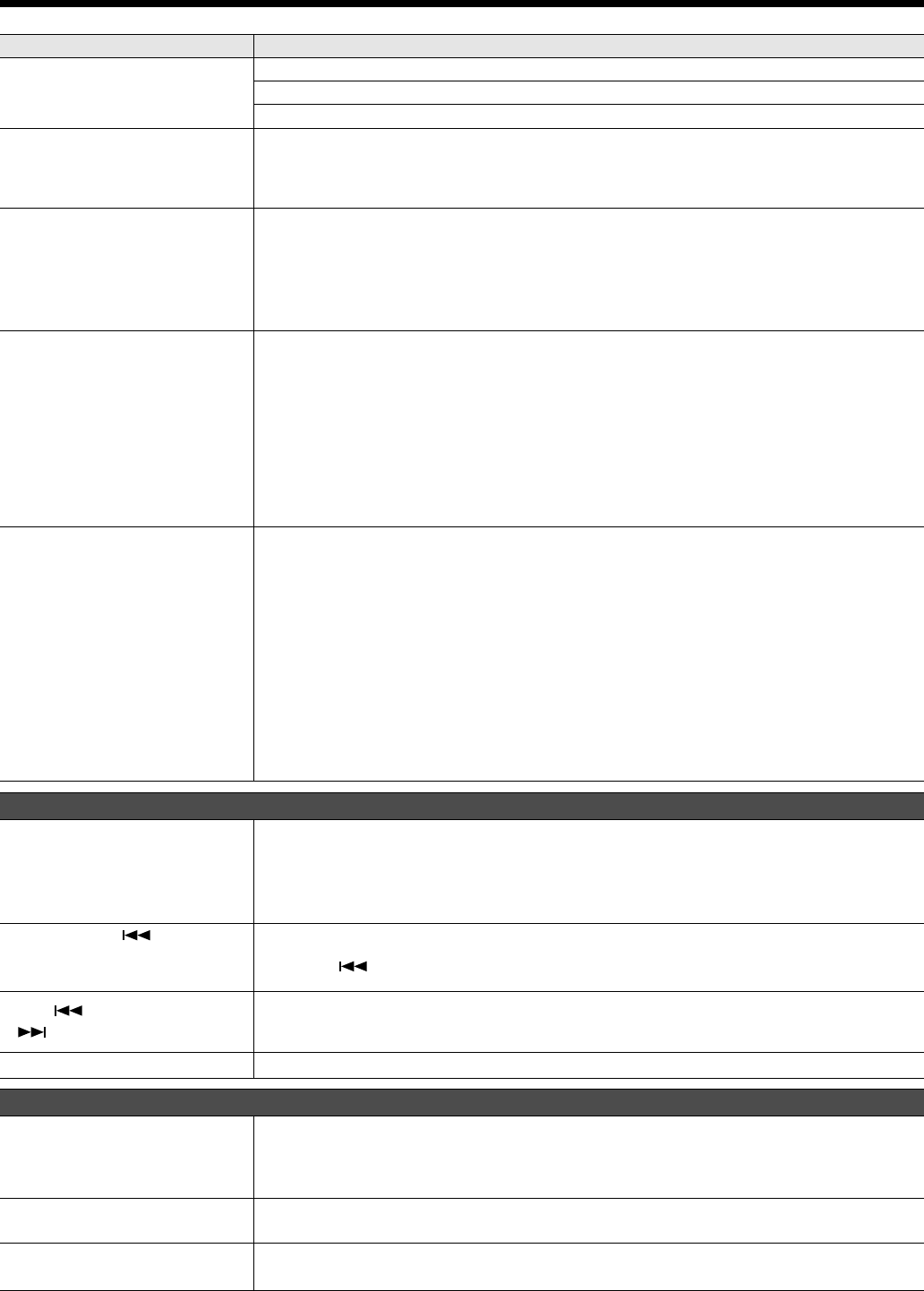
105
Troubleshooting
The tuning or pitch of the
keyboard or song is off
Have you set transpose? (p. 37, p. 61)
Are the settings for the “Temperament” and “Stretch Tuning” correct? (p. 65, p. 64)
Is the setting for the “Master Tune” correct? (p. 63)
Reverberation still audible
even with Reverb turned off
Since the RG-3’s piano sounds accurately reproduce the depth and reverberation of the orig-
inal acoustic piano, you may find that reverberation is audible when the Key Off Resonance
function is enabled. If you want to eliminate the reverberation, turn off the Key Off Resonance
function (p. 57).
In the upper range, the sound
changes abruptly beyond a
certain key
On an acoustic piano, notes in the upper one and a half octaves of the keyboard continue to
sound until they decay naturally, regardless of the damper pedal.
There is a difference in the timbre as well. Roland pianos faithfully simulate such characteris-
tics of the acoustic piano.
On the RG-3, the range that is unaffected by the damper pedal will change depending on the
Key Transpose setting.
A High-pitched whine is
produced
When listening through headphones:
Some of the more flamboyant and effervescent piano tones feature an ample high-end com-
ponent, which may make the sound appear to have metallic reverberation added.
Since this reverberation becomes particularly audible when supplemented by heavy reverb,
you may be able to diminish the problem by reducing the amount of reverb applied to the
sound.
When listening through speakers:
Here, a different cause (such as resonance produced by the RG-3) would be suspect. Consult
your Roland dealer or nearest Roland Service Center.
The bass range sounds odd, or
there is a vibrating resonance
When listening through speakers:
Playing at loud volumes may cause instruments near the RG-3 to resonate.
Resonation can also occur with fluorescent light tubes, glass doors, and other objects. In par-
ticular, this problem occurs more easily when the bass component is increased, and when the
sound is played at higher volumes. Use the following measures to suppress such resonance.
• Place speakers so they are 10–15 cm from walls and other surfaces.
• Reduce the volume.
• Move the speakers away from any resonating objects.
When listening through headphones:
Here, a different cause (such as resonance produced by the RG-3) would be suspect. Consult
your Roland dealer or nearest Roland Service Center.
Song doesn’t play back correctly
Song doesn’t play back
Does the screen indicate message, like “Delete User Song OK?” (p. 76).
The internal songs cannot be played back while recorded performance data remains in the
RG-3’s memory.
Erase the performance data or play back the song after saving to the “Favorites” or to your
USB memory.
Pressing the [ ] button
doesn’t return to the
beginning of the song
Some music files may contain settings that stop play at a point partway through the song.
Press the [ ] button several times more to return to the beginning of the song.
The [ ] and
[ ] buttons don’t work
If you attempt to play back performance data that contains more data than the entire capacity
of the RG-3’s memory, you may find that operations other than playback (such as rewind or
fast forward) become unavailable.
Accompaniment not playing
Is the accompaniment volume turned down in the volume balance settings? (p. 72)
Can’t record/Can’t play back
The recorded performance
has disappeared
Any performance that has been recorded is deleted when the power to the RG-3 is turned off
or a song is selected.
A performance cannot be restored once it’s been deleted. Be sure to save it on a USB memory
or User Memory before you turn off the power (p. 77).
Unable to play back songs
Could you have pressed the remote control’s [MUTE] button and muted the sound?
Press the [MUTE] button to cancel the mute (p. 35).
Can’t play back a song from
CD
Reading of data from the CD starts when the CD is inserted in the drive.
It may take a few moments to complete reading of the data.
Case Cause/Remedy


















